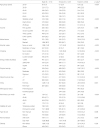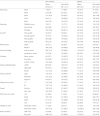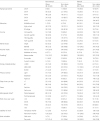1. Parent-Thirion A, Vermeylen G, van Houten G, Lyly-Yrjänäinen M, Biletta I, Cabrita J, et al. Fifth European Working Conditions Survey: Overview Report. Luxembourg. 2012; doi:10.2806/34660.
2. McMenamin TM. A time to work: recent trends in shift work and flexible schedules. Mon Labor Rev. 2007; 130:3–15.
4. Garaulet M, Ordovás JM, Madrid JA. The chronobiology, etiology and pathophysiology of obesity. Int J Obes (Lond). 2010; 34(12):1667–83. DOI:
10.1038/ijo.2010.118. PMID:
20567242.
6. Pi-Sunyer FX. The obesity epidemic: pathophysiology and consequences of obesity. Obes Res. 2002; 10(Suppl 2):97S–104S. DOI:
10.1038/oby.2002.202. PMID:
12490658.
7. Proper KI, Koppes LLJ, Van Zwieten MHJ, Bemelmans WJE. The prevalence of chronic psychological complaints and emotional exhaustion among overweight and obese workers. Int Arch Occup Environ Health. 2012; 85(5):537–45. DOI:
10.1007/s00420-011-0703-y. PMID:
21947369.
8. Schulte PA, Wagner GR, Ostry A, Blanciforti LA, Cutlip RG, Krajnak KM, et al. Work, obesity, and occupational safety and health. Am J Public Health. 2007; 97(3):428–36. DOI:
10.2105/AJPH.2006.086900. PMID:
17267711.
9. Park TJ, Paek DM, Joh KO, Park JS, Cho SI. The Relationship between Shift Work and Work-related Injuries among Korean Workers. Korean J Occup Env Med. 2012; 24(1):52–60.
10. Chee H-L, Kandiah M, Khalid M, Shamsuddin K, Jamaluddin J, Nordin NAMM, et al. Body mass index and factors related to overweight among women workers in electronic factories in Peninsular Malaysia. Asia Pac J Clin Nutr. 2004; 13(3):248–54. PMID:
15331336.
11. Karlsson B, Knutsson A, Lindahl B. Is there an association between shift work and having a metabolic syndrome? Results from a population based study of 27,485 people. Occup Environ Med. 2001; 58(11):747–52. DOI:
10.1136/oem.58.11.747. PMID:
11600731.
12. Chen JD, Lin YC, Hsiao ST. Obesity and high blood pressure of 12-hour night shift female clean-room workers. Chronobiol Int. 2010; 27(2):334–44. DOI:
10.3109/07420520903502242. PMID:
20370473.
13. Zhao I, Bogossian F, Song S, Turner C. The association between shift work and unhealthy weight: a cross-sectional analysis from the Nurses and Midwives' e-cohort Study. J Occup Environ Med. 2011; 53(2):153–8. DOI:
10.1097/JOM.0b013e318205e1e8. PMID:
21270661.
14. Romero-Corral A, Somers VK, Sierra-Johnson J, Thomas RJ, Bailey KR, Collazo-Clavell ML, et al. Accuracy of Body Mass Index to Diagnose Obesity In the US Adult Population. Int J Obes. 2008; 32(6):959–66. DOI:
10.1038/ijo.2008.11.
15. Joseph L, Wasir JS, Misra A, Vikram NK, Goel K, Pandey RM, et al. Appropriate values of adiposity and lean body mass indices to detect cardiovascular risk factors in Asian Indians. Diabetes Technol Ther. 2011; 13(9):899–906. DOI:
10.1089/dia.2011.0014. PMID:
21714683.
16. Oliveros E, Somers VK, Sochor O, Goel K, Lopez-Jimenez F. The concept of normal weight obesity. Prog Cardiovasc Dis. 2014; 56(4):426–33. DOI:
10.1016/j.pcad.2013.10.003. PMID:
24438734.
17. Okorodudu DO, Jumean MF, Montori VM, Romero-Corral A, Somers VK, Erwin PJ, et al. Diagnostic performance of body mass index to identify obesity as defined by body adiposity: a systematic review and meta-analysis. Int J Obes (Lond). 2010; 34(5):791–9. DOI:
10.1038/ijo.2010.5. PMID:
20125098.
18. Hong SM, Oh HJ, Choi H, Kim JG, Lim SK, Kim EK, et al. Characteristics of body fat, body fat percentage and other body composition for Koreans from KNHANES IV. J Korean Med Sci. 2011; 26:1599–605. DOI:
10.3346/jkms.2011.26.12.1599. PMID:
22147997.
19. Kim MK, Han K, Kwon HS, Song KH, Yim HW, Lee WC, et al. Normal weight obesity in Korean adults. Clin Endocrinol (Oxf). 2014; 80:214–20. DOI:
10.1111/cen.12162. PMID:
23362933.
20. Heo M, Faith MS, Pietrobelli A, Heymsfield SB. Percentage of body fat cutoffs by sex, age, and race-ethnicity in the US adult population from NHANES 1999-2004. Am J Clin Nutr. 2012; 95:594–602. DOI:
10.3945/ajcn.111.025171. PMID:
22301924.
22. Di Lorenzo L, De Pergola G, Zocchetti C, L'Abbate N, Basso A, Pannacciulli N, et al. Effect of shift work on body mass index: results of a study performed in 319 glucose-tolerant men working in a Southern Italian industry. Int J Obes Relat Metab Disord. 2003; 27(11):1353–8. DOI:
10.1038/sj.ijo.0802419. PMID:
14574346.
23. Song IW, Woo KH, Kim JS, Yoon SY, Na JY, Yu JH, et al. Occupational factors associated with changes in the body mass index of korean male manual workers. Ann Occup Environ Med. 2013; 25(1):40. DOI:
10.1186/2052-4374-25-40. PMID:
24472722.
24. Suwazono Y, Dochi M, Sakata K, Okubo Y, Oishi M, Tanaka K, et al. A longitudinal study on the effect of shift work on weight gain in male Japanese workers. Obesity (Silver Spring). 2008; 16(8):1887–93. DOI:
10.1038/oby.2008.298. PMID:
18535539.
25. Nakamura K, Shimai S, Kikuchi S, Tominaga K, Takahashi H, Tanaka M, et al. Shift work and risk factors for coronary heart disease in Japanese blue-collar workers: serum lipids and anthropometric characteristics. Occup Med (Lond). 1997; 47(3):142–6. DOI:
10.1093/occmed/47.3.142. PMID:
9156468.
26. Ghiasvand M, Heshmat R, Golpira R, Haghpanah V, Soleimani A, Shoushtarizadeh P, et al. Shift working and risk of lipid disorders: a cross-sectional study. Lipids Health Dis. 2006; 5:9. DOI:
10.1186/1476-511X-5-9. PMID:
16606444.
28. Cipolla-Neto J, Amaral FG, Afeche SC, Tan DX, Reiter RJ. Melatonin, energy metabolism, and obesity: A review. J Pineal Res. 2014; 56:371–81. DOI:
10.1111/jpi.12137. PMID:
24654916.
29. Antunes LC, Levandovski R, Dantas G, Caumo W, Hidalgo MP. Obesity and shift work: chronobiological aspects. Nutr Res Rev. 2010; 23(2010):155–68. DOI:
10.1017/S0954422410000016. PMID:
20122305.
30. Romon M, Edme JL, Boulenguez C, Lescroart JL, Frimat P. Circadian variation of diet-induced thermogenesis. Am J Clin Nutr. 1993; 57(4):476–80. PMID:
8460600.
31. Bray MS, Young ME. Circadian rhythms in the development of obesity: Potential role for the circadian clock within the adipocyte. Obes Rev. 2006; 8(2):169–81. DOI:
10.1111/j.1467-789X.2006.00277.x. PMID:
17300281.
32. Tsigos C, Chrousos GP. Hypothalamic-pituitary-adrenal axis, neuroendocrine factors and stress. J Psychosom Res. 2002; 53(4):865–71. DOI:
10.1016/S0022-3999(02)00429-4. PMID:
12377295.
33. Vale W, Spiess J, Rivier C, Rivier J. Characterization of a 41-residue ovine hypothalamic peptide that stimulates secretion of corticotropin and beta-endorphin. Science. 1981; 213(4514):1394–7. DOI:
10.1126/science.6267699. PMID:
6267699.
34. Yanagita S, Amemiya S, Suzuki S, Kita I. Effects of spontaneous and forced running on activation of hypothalamic corticotropin-releasing hormone neurons in rats. Life Sci. 2007; 80(4):356–63. DOI:
10.1016/j.lfs.2006.09.027. PMID:
17067638.
35. Manenschijn L, van Kruysbergen RGPM, de Jong FH, Koper JW, van Rossum EFC. Shift work at young age is associated with elevated long-term cortisol levels and body mass index. J Clin Endocrinol Metab. 2011; 96(11):E1862–5. DOI:
10.1210/jc.2011-1551. PMID:
21880805.
37. Lallukka T, Sarlio-Lähteenkorva S, Kaila-Kangas L, Pitkäniemi J, Luukkonen R, Leino-Arjas P. Working conditions and weight gain: A 28-year follow-up study of industrial employees. Eur J Epidemiol. 2008;23:303-10.
38. Wada K, Katoh N, Aratake Y, Furukawa Y, Hayashi T, Satoh E, et al. Effects of overtime work on blood pressure and body mass index in Japanese male workers. Occup Med (Chic Ill). 2006;56(8):578-80.
39. Jang TW, Kim HR, Lee HE, Myong JP, Koo JW. Long Work Hours and Obesity in Korean Adult Workers. J Occup Health. 2013;55:359-66.
40. Di Milia L, Mummery K. The association between job related factors, short sleep and obesity. Ind Health. 2009;47(4):363-8.
41. Magee CA, Caputi P, Iverson DC. Short sleep mediates the association between long work hours and increased body mass index. J Behav Med. 2011;34(2):83-91.
42. Lovejoy JC, Sainsbury A. Sex differences in obesity and the regulation of energy homeostasis: Etiology and pathophysiology. Obes Rev. 2009;10(2):154-67.
43. Woods SC, Gotoh K, Clegg DJ. Gender differences in the control of energy homeostasis. Exp Biol Med. 2003;30(3):396-404.
44. Toth MJ, Tchernof A, Sites CK, Poehlman ET. Effect of menopausal status on body composition and abdominal fat distribution. Int J Obes Relat Metab Disord. ENGLAND; 2000;24(2):226-31.
45. Lovejoy JC, Champagne CM, de Jonge L, Xie H, Smith SR. Increased visceral fat and decreased energy expenditure during the menopausal transition. Int J Obes (Lond). 2008;32(6):949-58.
46. Lallukka T, Lahelma E, Rahkonen O, Roos E, Laaksonen E, Martikainen P, et al. Associations of job strain and working overtime with adverse health behaviors and obesity: Evidence from the Whitehall II Study, Helsinki Health Study, and the Japanese Civil Servants Study. Soc Sci Med. 2008;66(8):1681-98.
47. Kivimäki M, Head J, Ferrie JE, Shipley MJ, Brunner E, Vahtera J, et al. Work stress, weight gain and weight loss: evidence for bidirectional effects of job strain on body mass index in the Whitehall II study. Int J Obes (Lond). 2006;30:982-7.
48. Bara AC, Arber S. Working shifts and mental health - findings from the British Household Panel Survey (1995-2005). Scand J Work Environ Health. Finland; 2009;35(5):361-7.







